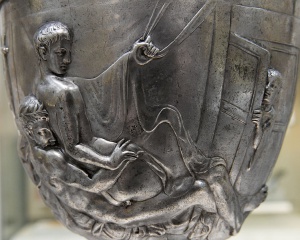Edward Perry Warren

Edward Perry Warren (January 8, 1860 – December 28, 1928), known as Ned Warren, was an American art collector and the author of works proposing an idealized view of homosexual and hebephilic relationships in the style of Greek love. He is now best known as the former owner of the Warren Cup in the British Museum.[1]
Biography
Warren was born on January 8, 1860, in Waltham, Massachusetts,[2]one of five children born into of a wealthy Boston, Massachusetts family. His father was Samuel Denis Warren, who founded the Cumberland Paper Mills in Maine.[3] His company is known today as S.D. Warren & Company. [4]
Warren had a strong "aesthetic instinct" as a child, and when he was about 3 years old, he would steal the china from his mother's cabinets, hide it under his bed, and inspect it at night. While the other Warren children and their friends played Cowboys and Indians, Ned would wander about the countryside alone in a Roman toga of his own making. He also "fell in love" with several other boys at school. He wrote a poem for one of these boys, comparing him to Hadrian's favorite youth, Antinous. He at times visited the house of a boy he "worshipped" and looked at him through the window for some time. One day, as he was staring through the boy's window, he heard a laugh behind him and turned around to find his maid had tracked him down. He took her into his confidence and she was able to borrow a photo of the boy for him, which was tintyped before it was returned. Ned kept the photo-copy as one of his "treasures" (another was the boy's autograph).
Ned was also a fan of Oscar Wilde, saying that after he read his lecture on "The English Renaissance", "I lost my head at once" [4]. He wished to see Wilde on his 1882 lecture tour of America and Canada. His brother, Sam, did not like Wilde and urged Ned not to see him, but he did meet him later in New York City.
He received his B.A. from Harvard College in 1883[2] and later studied at New College, Oxford, earning his M.S. in Classics.[3] His academic interest was classical archeology. At Oxford he met archeologist John Marshall (1862–1928), a younger man he called "Puppy,"[5] with whom he formed a close and long-lasting relationship, though Marshall married in 1907, much to Warren's dismay.[5] Beginning in 1888, Warren made England his primary home. He and Marshall lived together at Lewes House, a large residence in Lewes, East Sussex, where they became the center of a circle of like-minded men interested in art and antiquities who ate together in a dining room overlooked by Lucas Cranach's Adam and Eve, now in the Courtauld Institute of Art. One account said that "Warren's attempts to produce a supposedly Greek and virile way of living into his Sussex home" produced "a comic mixture of apparently monastic severity (no tea or soft chairs allowed) and lavish living."[6]
Warren spent much of his time in Continental Europe, collecting art works many of which he donated to the Museum of Fine Arts, Boston, assembling for that institution the "largest collection of erotic Greek vase paintings " in the U.S.[7] He has been described as having "a taste for pornography" and a "pioneer" in collecting it.[8] His published works include A Defence of Uranian Love in three volumes, which proposes a type of same-sex relationship similar to that prevalent in Classical Greece, in which an older man would act as guide and lover to a younger man.
In 1900 Warren published The Prince who did not Exist, a small edition art book from the Merrymount Press, "a most beautiful specimen of workmanship" according to the New York Times.[9]
Select works
- The Prince who did not Exist (1900)
- Classical and American Education (Oxford, B.H. Blackwell, 1918)[10]
- Alcmaeon, Hypermestra, Caeneus (Oxford: B.H. Blackwell, 1919)[11]
- A Tale of Pausanian Love (1927), under the pseudonym Arthur Lyon Raile
- A Defence of Uranian Love, 3 vols. (privately printed, 1928–30), under the pseudonym Arthur Lyon Raile
See also
References
- ↑ This article was originally based on the Wikipedia entry of the same name
- ↑ 2.0 2.1 New York Times: "Edward Perry Warren," December 30, 1928, accessed October 27, 2011
- ↑ 3.0 3.1 Lewes District Council: "The Story of Lewes House", accessed October 27, 2011
- ↑ 4.0 4.1 David Sox, Bachelors of Art: Edward Perry Warren & the Lewes House Brotherhood, (Fourth Estate, 1991)
- ↑ 5.0 5.1 BrightonOurStory: Auguste Rodin/Edward Perry Warren," Issue 6, Summer 1999, accessed October 27, 2011
- ↑ New York Times: Herbert W. Horwill, "News and Views of Literary London," August 17, 1941, accessed October 27, 2011. Horwill was reporting Desmond MacCaryhy's review of Burdett and Goddard's biography of Warren in the Times Literary Supplement.
- ↑ New York Times: James R. Mellow, "A new (6th century B.C.) Greek vase for New York," November 12, 1972, accessed October 27, 2011
- ↑ New York Times: Glen Bowersock, "Open House for the Ancients," April 18, 1999, accessed October 27, 2011
- ↑ New York Times: "Artistic Commercial Printing," May 26, 1900, accessed October 27, 2011
- ↑ The Contemporary Review, vol. 114, 701-3 available online, accessed October 27, 2011
- ↑ Archive.org: Alcmaeon, Hypermestra, Caeneus, accessed October 27, 2011